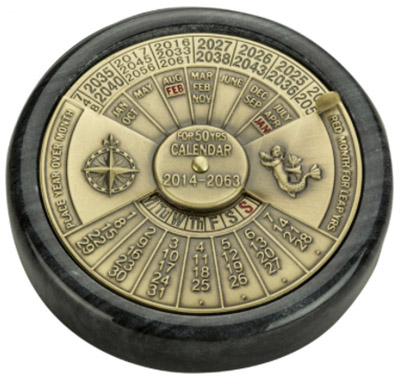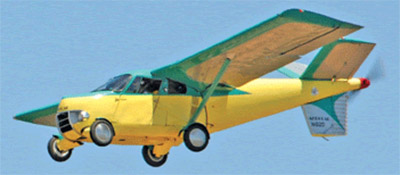
|
About twenty years ago, I used to keep on my desk—partly as ornament, partly paperweight, and somewhat as a useful device when I was writing fiction about the near future—a perpetual calendar like the one pictured here. It was a simple device: You align the month on the inner dial with the intended year on the outer dial, then read off the dates for the days of the week in the window at bottom. It took a minute to set, being mindful of leap years, and gave accurate readings over a span of fifty years.
This was a form of computer with no electronics and only one moving part. It was the sort of thing we all used to find specific information before we could carry a computer in our pockets that is the size of a deck of cards—and now wear one on our wrists that is the size of a matchbox.
I am of two minds about this, because I have always loved small devices with screens and keyboards. That love goes back to the first toy that my father made for me when I was about three years old. It was a box with a series of toggle switches and a line of small lights with red, green, yellow, and blue lenses. When you threw the switches, the lights would come on in different orders. It did nothing useful, except fascinate a small child. But it fixed my mind in a pattern that endures to this day.
Ever since the dawn of the Microprocessor Age, I have been chasing the ultimate handheld computer. It started with the first “personal digital assistants,” or PDAs, usually made in Japan and with crippled keyboards that required you to hold down three not-all-that-obvious keys to get a capital letter or a punctuation mark. Being a book editor and a stickler for form, I laboriously worked to get the right spelling and punctuation in my entries, so using the thing productively took forever. I then adopted, in rapid succession, a Palm Pilot—where you spelled everything out with a stylus or your fingertip—and then a variety of Hewlett-Packard calculators and tiny computers, chasing that holy grail.
My first cell phone had the traditional arrangement of rotary-dial numbers as a limited form of keyboard. That is, the digits 2 to 9 were each accompanied by three letters in sequence from the alphabet.1 You could store people’s names and numbers in the phone’s memory by “typing” them in using the keypad: Press 2 once for A, twice for B, three times for C, and wait a bit for the phone to sort out the right code and show your desired letter. And, of course, there were no lower-case letters or punctuation. It was really easier to keep your phone list separately, in a booklet or on a piece of paper, except that then your friends wouldn’t be on speed dial. But I digress …
Before we had computers at our fingertips, we had all sorts of handy ways to work out useful information.
The oldest is probably the Antikythera mechanism, a device of brass with geared wheels, now encrusted with corrosion and coral, discovered in a shipwreck off the Greek island of Antikythera in 1901. It has since been dated to about 200 BC, and x-rays of the gears and a reconstruction of their turning suggest that the mechanism was used to calculate astronomical positions and possibly to predict solar eclipses. The corollary would be the modern mechanical orrery, which dates back to the late medieval period and shows the positions of the sun and planets at any particular point in their continuously revolving orbits.
But mechanical representations of physical conditions are not the only form of ancient computer.
When I was compiling engineering resumes at the construction company, I came across a man whose work responsibilities included compiling “nomographs.” At first, I thought this was a typo and that he must actually be writing monographs—a literary pursuit, but an odd one for an engineer. Further checking revealed that, no, he really did make nomographs, also called nomograms. These are two-dimensional diagrams representing a range of variables associated with a mathematical function, usually shown as number sets along two or three parallel lines. Rather than solve the function mathematically, all an inquiring engineer had to do was draw a line of the correct angle across the parallel lines to achieve the answer.
As a form of computer, the nomograph is just a little more complex than a table of common logarithms2 or a telephone book—closer to a database than a calculation. And if we’re going to call a computer any device that gives you accurate astronomical readings, then a sailor’s sextant for “shooting the sun” at noon to determine latitude—and before that the astrolabe for calculating the angle between the horizon and the North Star—are also in the running as early “computers.”
But the point of this meditation is not to show how clever ancient peoples were but how much we are losing in the digital age. Orreries and sextants are now mechanical curiosities and decorative artifacts—the one lost to telescopes and observational satellites tied into much more sophisticated computer modeling, the other lost to satellite-based global positioning systems (GPS). Nobody writes nomographs anymore. The phone company doesn’t even publish the Yellow Pages anymore, or not on paper. Everything is online. And I can answer texts from friends by drawing letters with my fingertip—in both upper and lower case, with punctuation—on the crystal face of my Apple Watch, which doesn’t even need a keyboard.
The knowledge of the entire world along with real-time information, like GPS positioning and footstep counting with conversion to calories, is in our pockets and on our wrists. And that’s a wonderful thing.
But when the batteries die—or when future archeologists dig my Apple Watch out of a shipwreck, corroded with salt and perfectly nonfunctional—we will be left with lumps of silicon and dozens of questions. Who will draw the nomographs then?
1. Except for the 7, which picked up P, Q, R, and S, and the 9, which had W, X, Y, and Z. Presumably Q, X, and Z weren’t expected to get much use.
2. And a little less complex than a slide rule.
